Life has never been simple for IT leaders, but these days, complexity is shifting into high gear. This is the key lesson from our fifth survey on information technology strategy and spending. We asked 864 executives, including chief information officers (CIOs), chief technology officers (CTOs), other executives in the IT function, and C-level executives in other functions about their organizations’ business technology agenda, their adoption of emerging technologies, and the impact of IT on management practices.1
The demands on IT, results show, are more intense than ever. While many organizations express basic satisfaction with their own IT departments, new hurdles face IT executives as business units are demanding more value from the function. C-suite leaders are pressing IT executives for gains from transformational technologies like cloud computing, and they want IT to help turn growing stores of corporate data into information assets that support growth and guide innovation. And all this is playing out in a more challenging IT environment as competitors wield new technologies to wrest competitive gains and shape new product offerings.
Coping with competitive demands
Technology, undeniably, is changing competitive dynamics. Respondents describe this as a double-edged sword: IT is both a competitive weapon and a source of disruption when used by competitors. For the third year running, executives say their companies are most vulnerable to two technology-enabled threats: rising customer expectations and significant changes in delivery costs (Exhibit 1). This year, as companies begin to consider a return to growth, two other concerns leapt up the list from much lower rankings in previous surveys: the emergence of new products or services from competitors and competitors’ development of new offerings outside their current scope, such as telecommunication companies offering cloud-computing services.
The somewhat better news for those managing IT is that pressure to slash costs while simultaneously responding to these threats has eased somewhat. Respondents report that IT is becoming more than a simple cost center in the minds of many executives. Compared with earlier surveys, a smaller share—23 percent—say IT’s primary contribution to the corporation is in delivering IT services at the lowest cost, down from 25 percent in 2009 and 33 percent in 2008. Instead, more IT and non-IT executives are expecting IT to help drive broader business efficiency (39 percent) and differentiated performance (21 percent) this year. These expectations are reflected in executives’ beliefs about current IT priorities for their organizations: two of the top three priorities center on using IT to improve business performance (Exhibit 2).
Disruptions to business
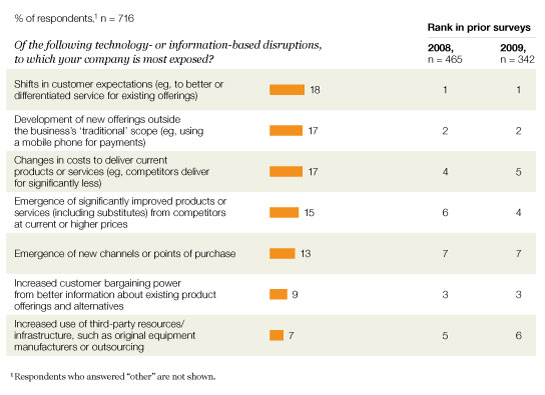
Driving better performance

Faced with demands on several fronts, IT leaders are responding with something of a juggling act. Similar to responses from last year, executives continue to hammer down IT operating costs for 2011 (Exhibit 3). The primary tactic in this battle is reduction of structural costs within IT and across the organization, and executives expect to keep at it in the near future (Exhibit 4). However, more drastic short-term demand reductions, such as deferring or scaling back projects, fell to the bottom of rankings since last year, when they were higher priorities.
The IT budget cycle
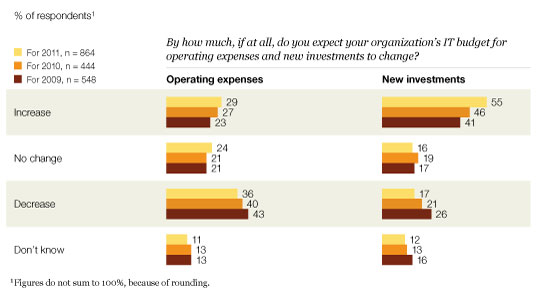
Responding to the downturn

The silver lining to all of this discipline is that companies remain committed to investing in new IT capabilities. To grow the business and counter technology-based threats, 55 percent of executives indicate that their companies will be increasing new IT investments in 2011. Eighteen percent expect an increase of more than 10 percent, while fully a third of respondents expect these investments to increase by 6 percent or more.
Importantly, though, IT will have to overcome concerns about its ability to deliver on these new investments. Between 20 and 25 percent of IT and non-IT executives alike say they are very or extremely satisfied with IT’s ability to engage with business partners on tech-driven ideas or projects, but fully 40 percent of executives from both groups say they are not at all or only slightly satisfied with IT’s effectiveness in this area.
Managing the future
IT leaders cite new demands and expanded mandates related to two increasingly important technology-based innovations: integrating data and analytics more completely into business decisions, and taking greater advantage of emerging cloud computing platforms.
Business intelligence and analytics are changing the way executives make decisions. Two-thirds of respondents say the business processes and decisions within their spheres of influence are becoming more data driven. They also believe this trend is spreading more broadly throughout their organizations, though just under half say their companies are steadily increasing their use of data across all functions. The other half cite specific functions that are leading the charge, most often marketing and product development.
Respondents who have incorporated data and analytics into their decision making say the most significant benefits are the discovery of new insights (39 percent), significantly improved projections of future performance (34 percent), and faster decision making (29 percent). Despite optimism about the rising use of data in decision making, respondents also highlight a number of barriers to expanding adoption (Exhibit 5).
Data and decision making
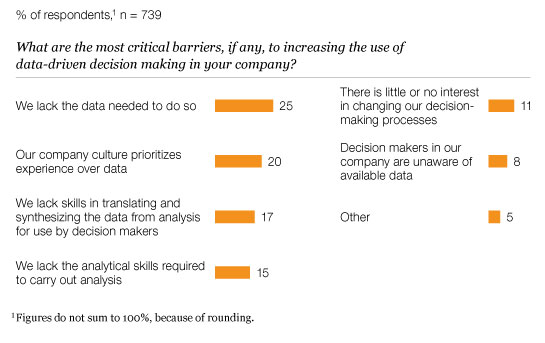
In recent years, IT executives have also focused more attention on cloud computing.2 Our results show that this interest in potential benefits is spreading to business leaders, with the cloud’s promise of increased agility a particularly attractive feature (Exhibit 6).
The value of cloud computing
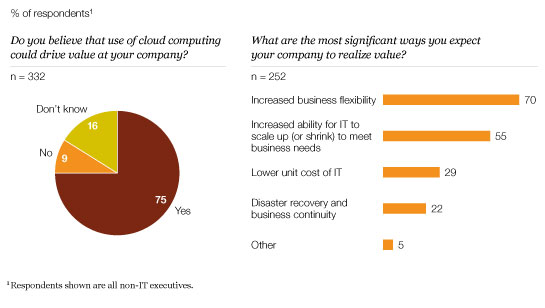
More than 80 percent of IT respondents say their companies are using or experimenting with cloud technology. Some 63 percent say their companies are using cloud-based applications in some aspect of day-to-day operations, and over the next 12 to 18 months, deployment and piloting is expected to increase across all application types explored in the survey (Exhibit 7).
Adopting the cloud
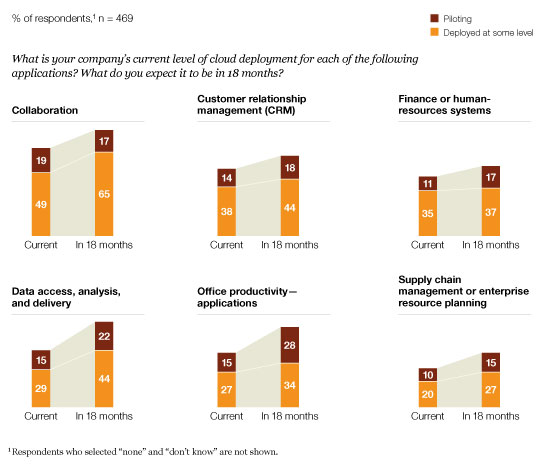
Yet that anticipated expansion faces a few hurdles, and the responsibility falls upon IT leaders to surmount them. When we asked about barriers to cloud adoption, IT and non-IT executives raise a number of significant issues (Exhibit 8). Non-IT executives are most concerned about a lack of organizational awareness, a barrier that ranks higher than security concerns. This underscores leaders’ belief that the cloud can drive substantial value and that the potential risks are manageable.
Barriers to cloud technology
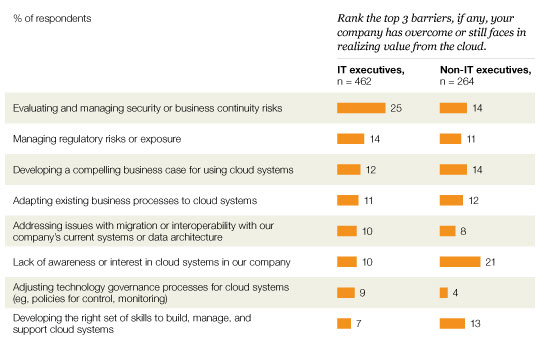
Looking ahead
Business leaders are looking to IT to drive value across the enterprise, which is understandable, given the centrality of IT systems to operations these days. However, this effort will tax IT executives, with whom satisfaction is currently fairly low. Company leadership needs to create cross-functional teams and build strong working relationships with executives across business units to deliver on this aspiration.
IT users throughout the business are becoming more sophisticated, due to the proliferation of IT and a range of innovative applications, and new cloud applications are relatively simple for even moderately savvy users to set up. This creates an easy end run around corporate IT unless IT executives continue experimenting with new platforms and capabilities and embrace new technologies while establishing clear ground rules and guidelines (for example, policies on data protection/storage or security reviews for cloud providers) to protect corporate interests.
Companies should promote key roles for non-IT executives; these leaders must continue to champion IT across the enterprise. The next wave of innovation will flow from joint efforts between business users and IT, a partnership that will demand top-down help to break down silos and foster cooperation.


